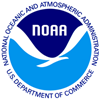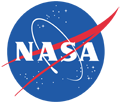FOOTPRINTS
The Earth is not flat.
That's the conceptual spark for the astounding movie created at the NASA Goddard Space Flight Center. Using an advanced media projection technology called Science On a Sphere developed by the National Oceanic and Atmospheric Administration (NOAA), FOOTPRINTS is the first fully produced film of its kind. The movie presents advanced satellite data and other visual effects on a dramatic spherical screen, affording viewers a chance to experience planets and planetary science in a way that's more natural to their actual appearance. The Earth guest stars in a variety of guises, from depictions of the biosphere to planetary views of city lights at night to dramatic examinations about the science of hurricane formation. Other moons and planets make exciting cameos too, with special presentations of Mars and Earth's moon.
Media and visualization experts at NASA began working with the NOAA technology in the fall of 2005. Until that time, Science On a Sphere had already established an impressive reputation for depiction of planetary data in a dramatic way. But FOOTPRINTS marks the first time that a thorough set of techniques and artistic rules have been applied in the service of a full featured production presented on a spherical screen.
But more than just a showcase for discrete data sets, the 16 minute film provides a conceptual framework about the human drive to explore. By contextualizing data with compelling language, inventive pictures, and dramatic sound, FOOTPRINTS seeks to engage and enthuse audiences who may not understand the practicalities and majesty of NASA's and NOAA's observations, and may not otherwise have any contact with what these two science agencies actually do.
As a presentation tool, Science On a Sphere is relatively new. NOAA invented and developed its core hardware and software within the past few years. According to Dr. Alexander MacDonald, the NOAA scientist located at the Earth System Research Laboratory in Boulder, Colorado, who originally conceived of it, Science On a Sphere is intended to present global science as it should be presented and to stimulate students to learn more about the Earth's environment and the solar system.
In the past few years Science On a Sphere systems have begun to be installed in museums and science centers around the world. Scientists and administrators at NASA Goddard saw potential to use the Sphere as both a teaching and an outreach tool and with NOAA's support decided to bring one to the campus. It's currently installed at the Goddard Visitor Center.
For several years there has been a slowly growing list of planetary data sets that can play on Spheres located in museums and institutions around the country. NASA and NOAA intend to dramatically augment that collection with new images and data. But FOOTPRINTS changes the playing field. With the release of this film, the Goddard team dramatically catapults forward the capabilities of the system, taking it far beyond its initial limits of merely depicting planetary data sets. Beyond encompassing state of the art data visualizations, the production team developed new ways for working with computer generated illustrations and animation, high definition video, graphics, text, and more. In a little more than three and a half months, the core group developed a palette of new technical processes and aesthetic guidelines for presenting media on the Sphere.
The movie asks audiences to consider the idea that what they know is only a function of what questions they're willing to ask. It's an intellectual and creative backdrop to the overall production, and also a philosophical backdrop to the excitement about the vital work that NASA and NOAA do in service of the public interest.
Credits
Official Movie Credits:
Written, Produced & Directed by
Michael Starobin
Edited by
Victoria Weeks
Art Direction
Susan Twardy
Music
Andre Gribou
Narration
Richard Foucheux
The Scientific Visualization Studio/NASA GSFC
Director of Data Visualization
Dr. Horace Mitchell
Visualization Team
Greg Shirah
Alex Kekesi
Lori Perkins
Dr. Tom Bridgman
Cindy Starr
Dr. Jeff de la Beaujardiere
James W. Williams
Marte Newcomb
Image Transformation
Greg Shirah
Dr. Horace Mitchell
Virtual Camera Rig and Seam Stitching
Alex Kekesi
Digital Earth PC
Eric Sokolowsky
Data Management and Compositing
Stuart Snodgrass
System Administration
Kevin Mahoney
Visualization Engineer
Randall Jones
Database Management
Joycelyn Thomson Jones
Next Generation Blue Marble Data Set
Reto Stockli
Nighttime Lights Image
Craig Mayhew
Robert Simmon
Additional Solar System Visualizations
Steve Albers, NOAA/CIRA
All other data sets from NASA sources
Set Construction, Practical Effects, & Animation
Chris Meaney, CI Labs, GSFC
HD Videography
Liz Smith
Titles and Sound Design
Michael Starobin
Recording Engineer
Mike Velle
Digital Photography
Chris Gunn
Victoria Weeks
Eric Erbe
Science On a Sphere Project Liaison
Maurice Henderson
Casting
Sandy Stern
Spalding Logo used by Permission
Antarctica Panaroma Courtesy
Guillaume Dargaud
http://www.gdargaud.net
Maple Trees Photograph Courtesy
Philip Greenspun
http://philip.greenspun.com
Apollo Panorama Courtesy
Moonpans.com
Piano & Keyboards
Andre Gribou
Trumpet
Ernie Bastin
Violin
Heather Pinson
Audio Production Consultant
Eric Arvai
Prelude in D Flat Major WTC Book 1. J.S. Bach
Executive Producer for Honeywell Technology Solutions, Inc.
Patrick Kennedy
Executive Producer for NASA Television, GSFC
Wade Sisler
It is only in our decisions that we are important.
--Jean-Paul Sartre
Science On a Sphere was Developed by NOAA

FOOTPRINTS

Copyright © 2006
All Rights Reserved
https://svs.gsfc.nasa.gov/10572
This item is part of this series:
Goddard Magic Planet Media
Keywords:
SVS >> Science On a Sphere
DLESE >> Narrated
NASA Science >> Planets and Moons











